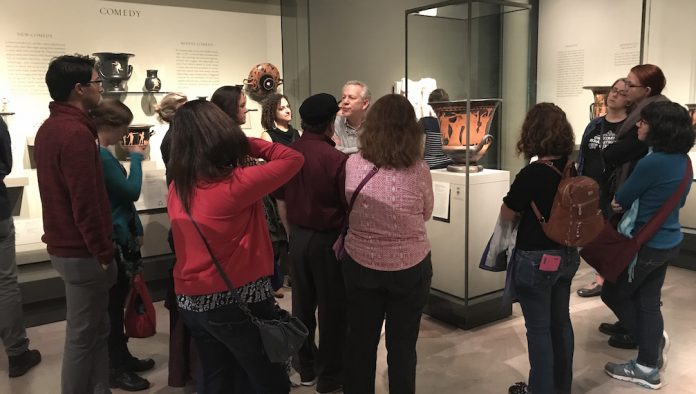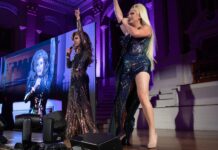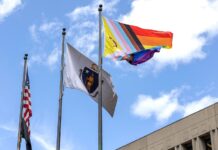At 6:30 p.m. on Wednesday, February 28, art historian Andrew Lear is leading his “Gay Secrets” guided tour through the Boston’s Museum of Fine Arts. The following article on Lear’s gay museum tours appears in the current January/February issue of Boston Spirit Magazine:
(For tickets and details on the Feb. 28 tour, click here.)
For historian Andrew Lear, art museums are among the gayest places on earth.
Lear, a Boston native and Harvard University graduate, fused his knowledge of art and LGBT history into a unique enterprise. Since 2013, his Oscar Wilde Tours offer guided strolls through some of the world’s most prestigious art museums in the U.S. and Europe, providing a deeper understanding and appreciation of art within an LGBT/transgressive gender role context.
Lear regularly conducts three different guided art tours at the Metropolitan Museum of Art in New York: “Gay Secrets” shines a light on homoerotic content, overt or covert; “Shady Ladies” highlights an assembly of courtesans, mistresses and sex-role-defying and gender-busting women throughout the ages; and the newest tour, “Nasty Women,” which he developed during the 2016 presidential election, showcases images of women who “shattered glass ceilings in ancient Egypt, imperial Rome and revolutionary France.”
The tours proved so popular that he recently launched a “Shady Ladies” tour at Boston’s Museum of Fine Arts.
The MFA “is a very gay museum,” he says.
For now, Lear conducts his tours on alternating Wednesday and Friday evenings (or by appointment for private groups). He’s hoping to add a “Gay Secrets” tour to his MFA schedule in the spring.
He describes the MFA edition as a mix of “Shady Ladies” and “Nasty Women,” with art that runs the gamut from Greek depictions of female mythology to works that take on the “war between the sexes.”
One of Lear’s favorite examples of powerful women rendered as frightening or monstrous is the Egyptian life-size bust of Cleopatra, easily identifiable by her crown and by the small serpent that decorates the base, by Italian sculptor Pier Jacopo Bonacolsi (known simply as “Antico”) who lived from about 1460 to 1528. Lear explains that the bust likely belonged to Isabella d’Este, Marchioness of Mantua, an influential arts patron of the Renaissance, which adds another layer of intrigue—a powerful woman owning the likeness of the ancient queen of Egypt.
Ancient Greece is Lear’s specialty, with particular expertise in gender and sexuality and male-male love in poetry and art. So it makes sense that his appreciation and knowledge, delivered in a down-to-earth accessible manner and sprinkled with wit, is often more illuminating than the art itself. Once he provides historical and cultural context, or points out a subtle object or facial expression hiding in plain sight, one can never look at the work in the same way.
Lear, who divides his time between New York City and Watertown, earned his undergraduate degree from Harvard as has taught at Columbia, Pomona College and New York University. But when his academic career met a crossroads, he decided to do what he loved and launched Oscar Wilde Tours.
“I had done tours for 15 summers during college and grad school, so I knew the tour industry pretty well, and I decided to try to put together tours focused on the kind of gay history issues I work on as a scholar,” he says.
In the MFA’s European collection, “so much art was made to be sexually titillating,” says Lear, a practice that was no longer necessary once photography was invented. There’s a Dutch painting set in a bordello that depicts the kinds of overt and subtle sexuality common to 18th century works. This was also the era when the modern version of marriage was invented, he notes.
There is overlap between “Shady Ladies” and “Gay Secrets.” One example is 19th-century American sculptor Harriet Hosmer’s most acclaimed work, “Sleeping Faun,” a marble statue of an inebriated, naked faun sprawled against a tree stump and a sensual rendering of an adolescent’s unselfconscious beauty. There’s a local connection, too; Hosmer, one of the 19th century’s most accomplished female artists, attended a progressive boarding school in Lenox, Massachusetts. After studying sculpture in the United States, she moved to Rome in 1852 to advance her education, becoming the first American woman sculptor to do so.
Another notable “shady lady” with Massachusetts ties is revealed in Ellen Day Hale’s gender-ambiguous self-portrait. Lear explains that Hale enjoyed a “Boston marriage” with fellow artist Gabrielle de Veauz Lements, whom she met in 1883. After they traveled and studied in Europe together, the women settled in Gloucester in a house that they named “The Thickets.”
Lear’s MFA tour also includes works by well-known women artists such as Mary Cassatt, Georgia O’Keefe and Frieda Kahlo. But what most fascinates Lear are the under-the-radar artists whose works reveals new discoveries. He points to Lois Maïlou Jones, a pioneering, Boston-born African American artist who was part of the Harlem Renaissance and who taught in Haiti. The influence of Haitian and African art can be seen in her vibrant, sensual painting “La Baker,” an homage to world-renowned entertainer Josephine Baker.
An important part of the art tours, for Lear, is just allowing people to experience art in a different way that might make it more accessible.
“People don’t know what to do in an art museum, and [museums] fail at helping them. It can be kind of intimidating. Art isn’t just meant to be beautiful. A vivid sense of context gives people a lot to hold onto so they can look at the work with a different understanding. It brings it to life.”
Visit www.oscarwildetours.com for more details.









